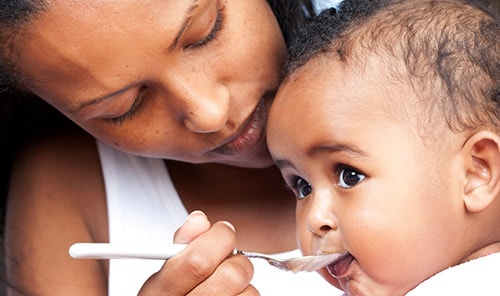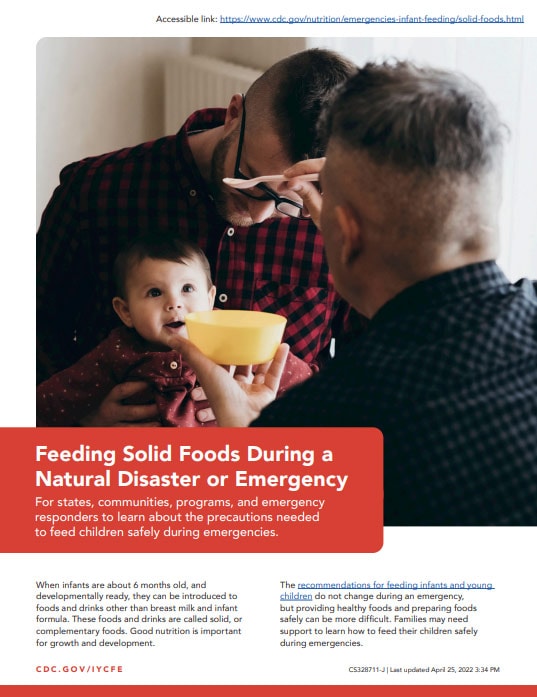Feeding Solid Foods During a Natural Disaster or Emergency
For states, communities, programs, and emergency responders to learn about the precautions needed to feed children safely during emergencies.
When infants are about 6 months old, and developmentally ready, they can be introduced to foods and drinks other than breast milk and infant formula. These foods and drinks are called solid, or complementary foods. Good nutrition is important for growth and development. The recommendations for feeding infants and young children do not change during an emergency, but providing healthy foods and preparing foods safely can be more difficult. Families may need support to learn how to feed their children safely during emergencies.
Here are some ways to keep children healthy and safe while feeding solid foods during an emergency:
Before feeding young children:
- Check expiration dates and look for signs of damage, rust, or dents before providing any non-perishable foods.
- If using non-disposable items, check bottles, nipples, feeding tools, infant formula, or other food containers to see if they have encountered flood water or extreme temperatures. Throw away any items that have been affected.
- Check with families about dietary needs, restrictions, and allergies. Make sure these families receive food they can safely eat during food distribution.
How to feed young children:
- Make sure there is a place for families to wash their hands with soap and safe water before feeding children. If soap and safe water are not available, provide an alcohol-based hand sanitizer that contains at least 60% alcohol. Supervise young children when they use hand sanitizer to prevent swallowing the product.
- Follow all food service guidelines for how to prepare and serve food within a disaster shelter. Contact your local health department with questions.
- Make available disposable feeding items like cups, dishes, and utensils to feed children. If families have safe water and cleaning supplies to clean reusable feeding items, ensure that families clean infant feeding items well after each use.
- Families should prepare table foods that are the right texture for the child’s age and development. Foods may need to be mashed or chopped to feed young children safely.
- To help prevent choking in children who are just starting to eat solid foods, help families to prepare foods that can be easily dissolved with saliva and do not require chewing. Encourage them to feed their child slowly and in small portions and always watch young children while they are eating.
The American Academy of Pediatrics and the Dietary Guidelines for Americans 2020-2025 recommend that children be introduced to foods other than breast milk or infant formula when they are about 6 months old.
To learn more about infant and toddler feeding, visit CDC’s Infant and Toddler Nutrition website.

After feeding young children, make sure families:
- Use safe water and soap to clean bottles, nipples, cups, and other feeding supplies (if using non-disposable items).
- Place washed infant feeding items in a mesh bag to hang dry.
- Throw away any leftover food that cannot be stored safely.
Nutrient-dense foods from each food group can be offered. Some examples include:
- Fruits: bananas, oranges, melons, or avocados
- Vegetables: cooked carrots, peas, or beets
- Grains: whole grain breads, cereals, or pastas
- Proteins: soft, small pieces of beef, lamb, chicken, fish, or turkey
- Dairy: pasteurized yogurts or cheeses
Avoid foods with added sugars and foods higher in sodium.
For more information on infant feeding, solid food feeding, and safe handling of infant feeding items, visit these webpages:
- CDC Infant and Toddler Nutrition website
- Disaster Planning: Infant and Child Feeding
- How to Clean Infant Feeding Items During Emergencies
- Foods and Drinks to Encourage
- Foods and Drinks to Limit
- Proper Storage and Preparation of Breast Milk
- How to Prepare and Store Powdered Infant Formula During an Emergency

